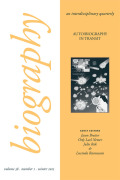Auto/biography in Transit
Guest Editors: Jason Breiter, Orly Lael Netzer, Julie Rak, & Lucinda Rasmussen
EDITORS’ INTRODUCTION
Introduction: Auto/Biography in Transit
Jason Breiter, Orly Lael Netzer, Julie Rak, Lucinda Rasmussen, v
The essays in this special issue engage with a range of issues relating to Auto/Biography in Transit, the title of the 2014 International Auto/Biography Association (IABA) conference held in Banff, from which the issue emerged. The essays have been divided into two areas of inquiry: Documents and Displacements. Those in the first section address the status of the document as a technology of the self, or think about how cultural producers document their lives. Essays in the second section explore critical approaches and texts that signify how both the study of life writing and its objects of inquiry are themselves in transit, and have the potential to change our ideas about the field itself.
ARTICLES
Documents
The Seeing Eye of Scientific Graphic Biography
Candida Rifkind, 1
This article examines two graphic biographies about Robert Oppenheimer that use visual strategies to overcome some of the narrative problems of prose scientific biography. I argue that we consider scientific graphic biography as a specific genre that installs a biographical eye (as opposed to the auto/biographical I) to explore the complex relationship between empirical knowledge and affective experience that shapes lives caught between science and politics.
The Guantánamo Lawyers: Life Writing for the “Courts of Public Opinion”
Terri Tomsky, 23
This article explores the strategic deployment of the life narrative genre by the lawyers of designated enemy combatants as part of the human rights activism against the unlawful detainment of prisoners at the US military prison in Guantánamo.
The Diary and the Commonplace Book: Self-Inscription in The Note Books of a Woman Alone
Ella Ophir, 41
The Note Books of a Woman Alone (1935), the posthumously published notebooks of an impoverished London clerk, provokes reconsideration of what counts as an individual voice. More than half the text is comprised of quotations and extracts; Evelyn Wilson’s textual collecting, however, was deeply enmeshed with her diary writing. Blurring transcription and expression, her practice of self-inscription lays bare the intersubjective nature of self-definition and the composite nature of any textual voice.
“Contiguous But Widely Separated” Selves: Im/Migrant Life Narrative as Data-Driven Form
Elizabeth Rodrigues, 56
This essay proposes that an epistemological commitment to data collection creates a distinct aesthetic in life narratives, and argues that an abundance of data creates a sense of multiple, co-present identities within a given subject. Focusing on The Life Stories of Undistinguished Americans, a collection of “lifelets” edited by Hamilton Holt (1906), Gertrude Stein’s Three Lives (1909), and The Soul of an Immigrant (1921), the autobiography of Constantine Panunzio, Rodrigues shows how the identities that these subjects iterate are in flux, and thus the subjects are constantly in transit among their identities.
Self-Branding, Hotness, and Girlhood in the Video Blogs of Jenna Marbles
Emma Maguire, 72
This essay explores the significance of online celebrity and self-branding through the case study of popular YouTube video blogger Jenna Marbles. I ask how the forces of commoditized web spaces shape self-representation, and explore how Marbles negotiates the demand for feminine “hotness” in this competitive, networked media landscape. Central to this essay is how girls use self-mediation to negotiate a system that insists on consuming them as objects, while maintaining their autonomy as subjects.
Displacements
Fictional Transits and Ruth Ozeki’s A Tale for the Time Being
Rocío G. Davis, 87
Focusing on Ruth Ozeki’s A Tale for the Time Being, this essay engages the transits between the fictional and the autobiographical by deploying notions from narratology, including a proposal regarding the difference between “fiction” and “the fictive,” reflections on metatextual performance, and the idea of the implied author.
Covering Pain: Pain Memoirs and Sequential Reading as an Ethical Practice
Leigh Gilmore, 104
Book design—including the elements of cover image and author photo—offer conceptual matter from which meanings of authorship and identity emerge. In the case of memoirs about chronic pain, these peritexts also employ a complicated visual iconography of disability that may rely on assumptions about agency and ability that pain memoirs themselves challenge within their covers. This essay explores how readers might bear witness to chronic pain memoirs by leveraging insights gained through the sequential reading of comics toward an ethical practice.
The (De)Evolution of a Genre: Pain Memoirs and Sequential Reading as an Ethical Practice
Lucinda Rasmussen, 118
This article traces how postfeminism, an ideology that celebrates consumerism and disavows feminism, has influenced the evolution of the breast cancer memoir. Paratexts surrounding three twenty-first century breast cancer memoirs are discussed to show how retailers and corporate cause marketers have in some instances impeded the delivery of feminist messages in some of these works.
Between Selves: An Intertextual Approach to Jamaica Kincaid’s Among Flowers
Ricia Anne Chansky, 135
Jamaica Kincaid’s second travel narrative, Among Flowers: A Walk in the Himalaya, remains an underexplored text due to the conflicted, diasporic subjectivity that readers encounter within the book. This essay argues for a reading strategy that positions Among Flowers in conversation with A Small Place to reveal a more nuanced understanding of Kincaid’s diasporic status.
CONTRIBUTORS, 152




